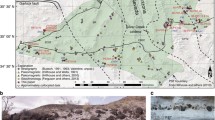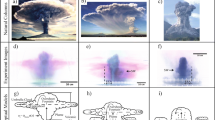Abstract
Analogue experiments in part I led to the conclusion that pyroclastic flows depositing very high-grade ignimbrite move as dilute suspension currents. In the thermo–fluid–dynamical model developed, the degree of cooling of expanded turbulent pyroclastic flows dynamically evolves in response to entrainment of air and mass loss to sedimentation. Initial conditions of the currents are derived from column-collapse modeling for magmas with an initial H2O content of 1–3 wt.% erupting through circular vents and caldera ring-fissures. The flows spread either longitudinally or radially from source up to a runout distance that increases with higher mass flux but decreases with higher gas content, temperature, bottom slope and coarser initial grain size. Progressive dilution by entrainment and sedimentation causes pyroclastic currents to transform into buoyant ash plumes at the runout distance. The ash plumes reach stratospheric heights and distribute 30–80% of the erupted material as widespread co-ignimbrite ash. Pyroclastic suspension currents with initial mass fluxes of 107-1012 kg/s can spread for tens of kilometers with only limited cooling, although they move as supercritical, strongly entraining currents for the eruption conditions considered here. With increasing eruption mass flux, cooling during passage through the fountain diminishes while cooling during flow transport increases. The net effect is that eruption temperature exerts the prime control on emplacement temperature. Pyroclastic suspension currents can form welded ignimbrite across their entire extent if eruption temperature is To>1.3.Tmw, the minimum welding temperature. High eruption rates, a large fraction of fine ash, and a ring-fissure vent favor the formation of extensive high-grade ignimbrite. For very hot eruptions producing sticky, partially molten pyroclasts, analysis of particle aggregation systematics shows that factors favoring longer runout also favor more efficient aggregation, which reduces runout. As a result, very high-grade ignimbrites cannot spread more than a few tens of kilometers from their source. In cooler pyroclastic currents, particles do not aggregate, and the sedimentation process may involve re-entrainment of particles, which potentially leads to more extensive cooling and longer runout; such effects, however, are only significant when net erosion of substrate occurs. Model results can be employed to estimate mass flux and duration of ignimbrite eruptions from measured ignimbrite masses and aspect ratios. The model also provides an alternative explanation of the observed decrease in H/Lratios with ignimbrite mass.
Similar content being viewed by others
Author information
Authors and Affiliations
Additional information
Received: 10 May 1998 / Accepted: 21 October 1998
Rights and permissions
About this article
Cite this article
Freundt, A. Formation of high-grade ignimbrites Part II. A pyroclastic suspension current model with implications also for low-grade ignimbrites. Bull Volcanol 60, 545–567 (1999). https://doi.org/10.1007/s004450050251
Issue Date:
DOI: https://doi.org/10.1007/s004450050251




